The words “full moon” in many languages

It is said that there are more than 6,000 languages worldwide (this is hard to imagine) and it is a fascinating concept to think, there are probably as many words for “full moon”.
Here we begin our little journey to the full moon. A few words about the fascinating quest of the greater purpose, that includes the full moon circulating through our lives. In layman’s terms and not always scientific (astronomy experts – don’t look too closely!). We would like to wish you illuminating moments. Enjoy!


It is said that there are more than 6,000 languages worldwide (this is hard to imagine) and it is a fascinating concept to think, there are probably as many words for “full moon”.
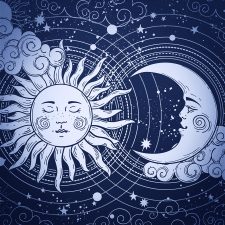
A full moon is when the Sun and the Moon are facing opposite, being in opposite direction from an Earth perspective.
This might feel astonishing if one imagines that the Moon is on one side, the Sun on the other and the Earth in between? Shouldn’t the Earth throw a shadow onto the Moon? Bingo – this is exactly what she does! But only when the Moon is exactly on the Earth orbit, the so called “ecliptic”. When this takes place, we speak of a lunar eclipse!
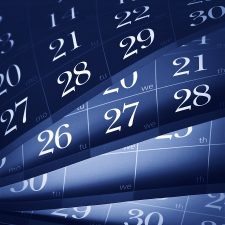
The Moon needs 27.33 days to circle around the Earth. Something that is also referred to as “sidereal time”. But because the Earth orbits the Sun, just like the Moon orbits the Earth, the Moon has to travel two further days in order to resume the same position to the Earth and Sun. This is then called the “sidereal time”. In order to determine the point of time of the reoccurring full moon, the sidereal time serves as basis.
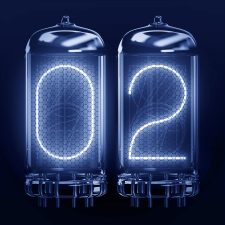
We already know now that the moon month is mostly shorter than the calendar month, being on average approximately 29.5 days. If full moon falls on the first or second of a month, it is possible that another full moon occurs in the same month, for instance in July 2004:
Friday, 2 July 2004, 01:08:54 pm
Saturday, 31 July 2004, 08:05:06 pm
This event is also known as “blue moon”.
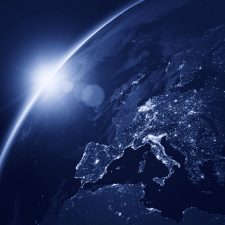
The answer is: “everywhere at the same time”. This refers to the so called Universal Time (UT) though, which is used for general astronomical events. We have already learnt that full moon is an astronomical event, where the moon, sun and the earth play a role by being in a specific position. So, full moon takes place at a specific time in the outer space. This point of time is specified by astronomers namely by the Universal Time.

There are multiple ways of approaching this question. If we look at it from a purely theoretical standpoint, we might be tempted to say that the full moon is infinitely short, since the phases of the moon are changing continuously. The moon is not yet quite full shortly before the full moon, and is already waning shortly afterwards.
However, there is a practical aspect that lets us quantify the full moon as a finite and measurable span of time: Since the Sun is significantly bigger than the Moon, its rays are able to reach just a little over half of the Moon’s surface. This means that the timespan in which the visible side of the Moon’s surface is irradiated (as seen from Earth) is longer than infinitely short.

Whether scientists, astrologers or esoterics, they agree on one thing: the moon influences earth and life on earth. For instance, it regulates the tides through its magnetism. Also continents feel the consequence of this magnetism and either raise or lower their position sometimes up to 26 cm.

In nature it is a known fact: for some animal species, mating takes place at full moon. However, the examples that can be found on this subject are rather simple. Full moon serves in some cases indirectly as the cause (for instance through the high water levels during the tides that the horseshoe crab uses to deposit its eggs) or also as the signal for both sexes of a species to begin at the exact same time to safeguard their future existence (a particular type of fly or also corals). It is understood that also wolves are led by full moon when it is time to mate.

… that people are looking for an argument at full moon or are especially happy …
… that if full moon is surrounded by a haze, a person dies …
… that you raise your hat three times to the moon (being a man) or you make a curtsey (being a woman), in order to protect yourself from misfortune until the next full moon …
… that whoever does not chink glasses with full moon at least once, does not deserve any happiness [Greek toast] …
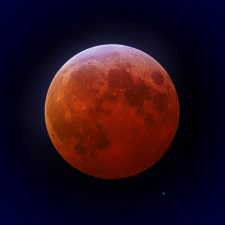
During a lunar eclipse, the Moon moves through the shadow of the Earth. Which means, that the Earth is positioned quite exactly between the Sun and Moon and casts its shadow onto the Moon. This is only possible at full moon and if some other requirements are met. Depending on whether the moon passes the partial or the core shadow of the Earth, we speak of a partial or total lunar eclipse.

Our Moon consists of rock, which was formed newly during its creation through a collision between the Earth and another planet, around 4.5 billion years ago. Lunar maria were created through meteoroid impacts, which can be seen as dark spots if observed from Earth.
A small amount of these rocks are on Earth. One part stems from a variety of moon missions (Apollo and Luna), the other from meteorites that struck the Earth as fragments. If you add up the registered mass of these rocks, you’ll end up with 738 kg (1,627 pounds). Which is actually »just a grain of rice« in comparison to the 81,000,000,000,000 kg that our Moon weighs.

As is generally known, the moonlight is actually sunlight reflecting from the surface of the Moon and reaching us here on Earth. You ask yourself the question, whether the moonlight may have a different colour than the sunlight, especially since a nightly scenery usually appears to be bluish. Also movie scenes, are portrayed in blue and so are many pictures and photographs. We would like to forestall the answer: the moonlight is nearly white. The night appears blue due to other reasons.

We had already told you about the paintings of romanticism by German painters Caspar David Friedrich (1774–1840) and Philipp Otto Runge (1777–1810). And also the English painter William Turner (1775–1851) had the moonlight in his mind. Here we are looking at the next generation and find the Dutch-Belgian artist Petrus van Schendel (1806–1870), whose speciality were the nightly moonlight sceneries. What distinguished him from his predecessors and colleagues, was that it were precisely those depictions of nightlight, which brought him fame and not an insignificant financial success (which was not a given for many painters).
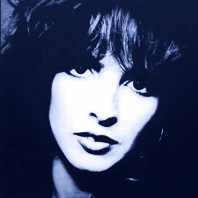
Nena and her band belong to the most successful artists in German music history. With »99 Luftballons« from 1983, she made a name for herself internationally and also reached 2nd place in the US charts with the English version »99 red balloons« [*]. This has only been accomplished by very few German musicians.
In the song »Vollmond« [full moon], also from 1983, Nena sings about the silver Moon and describes the romantic longing and restlessness, which can capture us during a full moon:

When the sunlight appears on the Moon’s surface in a flat angle, interesting lighting effects are created, due to the mountains and valleys, which can be observed quite well from the Earth. A well-known effect is the so called »golden handle«. This is when the Jura Mountains (»Montes Jura«) are illuminated 4 to 5 days before the full moon and appear as a bright arc, in front of the still darkened Sea of Showers (»Sinus Iridum«) of the Mare Imbrium. This is reinforced by the fact that the boundary of light and shadow, which is called »terminator«, runs directly through this area.

The tarot is a pack of playing cards that is used for mystical interpretations. It has a long tradition, possibly dating back to the ancient Egyptian time. Playing cards started to circulate in Europe at around the 14th and 15th century, among them also the so called “tarock” (in Italian “tarocchi”), which is considered to be the predecessor of what is now known as tarot, and still today established independently as a game of cards.
Over time, the symbolism and interpretation begins to move to the forefront and the cards become a popular tool for mystics and fortune tellers.

Everyone knows that the sun is much larger than the moon and much further away from earth. In this very context lies a fascinating fact: both celestial bodies appear to be of similar size on the firmament, when observed from earth. Which implies that the sun has to be as many times bigger than the moon, as it is further away from the earth than the moon from the earth …

Although, one could assume that the following concerns vampires or werewolves, we occupy ourselves with another kind of bite, namely the bite of animals to humans. There is a study of the E.R. department of the Bradford Royal Infirmatory in Bradford, England from 1997–1999. Here, the question, whether animals bite more often at the full moon, has been investigated. 1,621 patients were looked at, who had been treated for animal bites. The majority of affected patients had been bitten by dogs (95.1 %), others by cats (3.4 %), horses (0.8%) and rats (0.7 %). The surprising aspect of this study is, that indeed a significant connections could be detected between the full moon happenings and the animal bites. Hence, this should be the first study, known to us, which provides such a result!
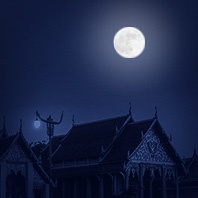
Māgha Pūjā is an important Buddhist holiday that is celebrated in Thailand, Laos, Cambodia, and Sri Lanka, on the day of the full moon, in the third month of the Thai moon calendar, in February/March. The word Māgha refers to month and Pūjā is the honoring. Legend has it that on this day 1,250 monks congregated to meet with Buddha.

When looking at the Moon, how slowly it travels across the night sky, one could easily forget that we are moving with a staggering speed through space with our Earth and our Moon. Furthermore, there is the rotation of the orbs to each other, which remains hidden from our senses as well. Only the mind knows of these astronomic connections and only for a short period of time (measured by our existence).